Orphans of the Genocide. The Georgetown Boys and Girls
Orphans of the Genocide. The Georgetown Boys and Girls –
The 100th anniversary of the Armenian Genocide will be commemorated on April 24, 2015. Beginning in 1915, the Ottoman Empire attempted to wipe out its Armenian population. Millions were murdered and thousands of children were left orphans.
Between 1923 and 1927, approximately 140 Armenian boys and girls came to live in Canada. These children were given new homes in Southern Ontario, the girls placed as domestic help with families in Toronto, most of the boys were placed on a collective farm in a town called Georgetown. The refugee children became known as “the Georgetown boys and girls.” An exhibit about these children can be found in the Actions Count gallery of our Museum.
Historians have suggested that the arrival of the Georgetown boys and girls in Canada constituted the nation’s first large-scale humanitarian effort, referring to the settlement scheme as “Canada’s Noble Experiment.”1This “noble experiment” resulted from the efforts of concerned citizens and nongovernmental organizations in lobbying William Lyon Mackenzie King’s Liberal government to ease restrictive immigration legislation and permit the arrival of the refugee children.

In the early 1920s, Canadian women and men formed the Armenian Relief Association of Canada (ARAC) to raise awareness of the plight of orphaned children abroad, and petitioned the government to grant funds for 5,000 children to migrate to Canada. The Association promised to provide shelter, food, education, and occupational training, and assured immigration officials that the children would be strong, healthy, and quickly assimilated.2 Ottawa initially declined to provide assistance, preferring to send financial relief abroad instead of granting refugees entrance into the Dominion, but ARAC was eventually able to persuade King to provide $25,000 to help its cause.
The efforts of religious and ethnic groups, individual lobbyists, and charitable organizations such as the ARAC continued long after the Georgetown boys and girls were admitted to Canada. Early humanitarians oversaw the children’s education and integration into broader society, struggling not just against discriminatory immigration policy at the federal level but also against popular prejudice at the societal level. The ARAC worked to convince fellow citizens that admitting foreign refugees would not threaten Canada’s British culture and heritage, trying to balance educating the children in English and in Canadian customs with instruction in Armenian language and culture.3

Despite the efforts of humanitarians to care for the Armenian orphans, however, some boys and girls did face significant challenges in adjusting to new lives in Canada. After the boys had spent several years living and working together on the Georgetown farm, the ARAC separated the orphans and sent them to individual family farms throughout Southern Ontario as indentured labour. While some adoptive families upheld the ARAC’s mandate of providing education until the age of 16, other families did not place the boys in school and exploited the children as farm labourers. As a result, some of the Georgetown boys lacked proper education, including the ability to read and write English, which posed significant problems for them as adults. In later years, when many of the boys tried to make lives for themselves in larger cities such as Toronto, the Armenian refugees faced popular discrimination on account of their cultural heritage and were denied educational and occupational opportunities. Several children felt as though they did not belong in Anglo-Canadian society.4 The Georgetown boys and girls later recalled their experiences growing up in Canada fondly, and many became involved in humanitarian and charitable work with immigrants, seeking to give back to the country that had taken them in as displaced children.
1. Hrag Vartanian, “The Georgetown Boys,” Armenian General Benevolent Union of America, (AGBU) Inc., 10 no. 2 (30 June 2000): 5.
2. Sean Fine, “Georgetown Boys: 60 Years Later,” The Globe and Mail (14 May 1985): 1.
3. Isabel Kapriellian-Churchill, “Rejecting ‘Misfits,’” 305; Isabel Kapriellian-Churchill,Like Our Mountains: A History of Armenians in Canada (Montreal and Kingston: McGill-Queen’s University Press, 2005): 157-158.
4. Kaprielian-Churchill, Like Our Mountains, 203.
Canadian Museum For Human Rights

